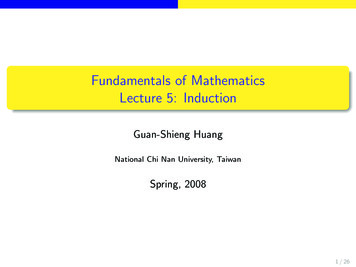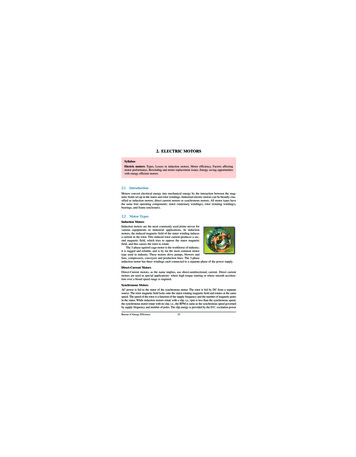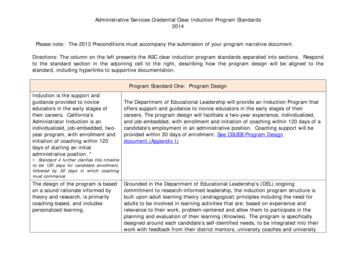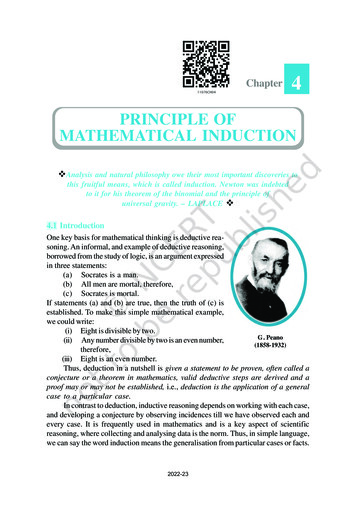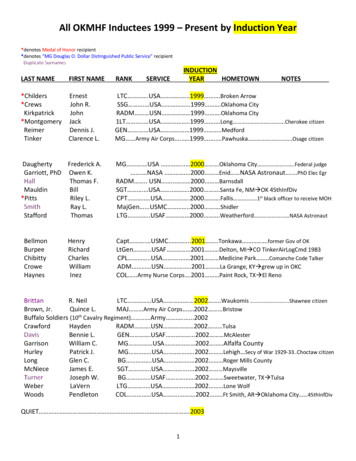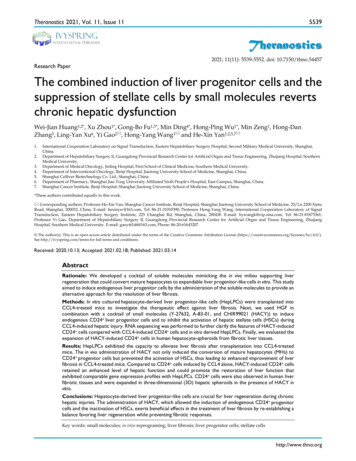
Transcription
Theranostics 2021, Vol. 11, Issue 11IvyspringInternational PublisherResearch Paper5539Theranostics2021; 11(11): 5539-5552. doi: 10.7150/thno.54457The combined induction of liver progenitor cells and thesuppression of stellate cells by small molecules revertschronic hepatic dysfunctionWei-Jian Huang1,2*, Xu Zhou1*, Gong-Bo Fu1,3*, Min Ding4*, Hong-Ping Wu1*, Min Zeng1, Hong-DanZhang5, Ling-Yan Xu6, Yi Gao2 , Hong-Yang Wang1 and He-Xin Yan1,2,5,7 1.2.3.4.5.6.7.International Cooperation Laboratory on Signal Transduction, Eastern Hepatobiliary Surgery Hospital, Second Military Medical University, Shanghai,China.Department of Hepatobiliary Surgery II, Guangdong Provincial Research Center for Artificial Organ and Tissue Engineering, Zhujiang Hospital, SouthernMedical University.Department of Medical Oncology, Jinling Hospital, First School of Clinical Medicine, Southern Medical University.Department of Interventional Oncology, Renji Hospital, Jiaotong University School of Medicine, Shanghai, China.Shanghai Celliver Biotechnology Co. Ltd., Shanghai, China.Department of Pharmacy, Shanghai Jiao Tong University Affiliated Sixth People's Hospital, East Campus, Shanghai, China.Shanghai Cancer Institute, Renji Hospital, Shanghai Jiaotong University School of Medicine, Shanghai, China.*These authors contributed equally to this work. Corresponding authors: Professor He-Xin Yan, Shanghai Cancer Institute, Renji Hospital, Shanghai Jiaotong University School of Medicine, 25/Ln 2200 XietuRoad, Shanghai, 200032, China. E-mail: hexinyw@163.com, Tel: 86-21-31010390; Professor Hong-Yang Wang, International Cooperation Laboratory of SignalTransduction, Eastern Hepatobiliary Surgery Institute, 225 Changhai Rd, Shanghai, China, 200438. E-mail: hywangk@vip.sina.com, Tel: 86-21-81875361;Professor Yi Gao, Department of Hepatobiliary Surgery II, Guangdong Provincial Research Center for Artificial Organ and Tissue Engineering, ZhujiangHospital, Southern Medical University. E-mail: gaoyi6146@163.com, Phone: 86-20-61643207. The author(s). This is an open access article distributed under the terms of the Creative Commons Attribution License (https://creativecommons.org/licenses/by/4.0/).See http://ivyspring.com/terms for full terms and conditions.Received: 2020.10.13; Accepted: 2021.02.18; Published: 2021.03.14AbstractRationale: We developed a cocktail of soluble molecules mimicking the in vivo milieu supporting liverregeneration that could convert mature hepatocytes to expandable liver progenitor-like cells in vitro. This studyaimed to induce endogenous liver progenitor cells by the administration of the soluble molecules to provide analternative approach for the resolution of liver fibrosis.Methods: In vitro cultured hepatocyte-derived liver progenitor-like cells (HepLPCs) were transplanted intoCCL4-treated mice to investigate the therapeutic effect against liver fibrosis. Next, we used HGF incombination with a cocktail of small molecules (Y-27632, A-83-01, and CHIR99021 (HACY)) to induceendogenous CD24 liver progenitor cells and to inhibit the activation of hepatic stellate cells (HSCs) duringCCL4-induced hepatic injury. RNA sequencing was performed to further clarify the features of HACY-inducedCD24 cells compared with CCL4-induced CD24 cells and in vitro derived HepLPCs. Finally, we evaluated theexpansion of HACY-induced CD24 cells in human hepatocyte-spheroids from fibrotic liver tissues.Results: HepLPCs exhibited the capacity to alleviate liver fibrosis after transplantation into CCL4-treatedmice. The in vivo administration of HACY not only induced the conversion of mature hepatocytes (MHs) toCD24 progenitor cells but prevented the activation of HSCs, thus leading to enhanced improvement of liverfibrosis in CCL4-treated mice. Compared to CD24 cells induced by CCL4 alone, HACY-induced CD24 cellsretained an enhanced level of hepatic function and could promote the restoration of liver function thatexhibited comparable gene expression profiles with HepLPCs. CD24 cells were also observed in human liverfibrotic tissues and were expanded in three-dimensional (3D) hepatic spheroids in the presence of HACY invitro.Conclusions: Hepatocyte-derived liver progenitor-like cells are crucial for liver regeneration during chronichepatic injuries. The administration of HACY, which allowed the induction of endogenous CD24 progenitorcells and the inactivation of HSCs, exerts beneficial effects in the treatment of liver fibrosis by re-establishing abalance favoring liver regeneration while preventing fibrotic responses.Key words: small molecules; in vivo reprograming; liver fibrosis; liver progenitor cells; stellate cellshttp://www.thno.org
Theranostics 2021, Vol. 11, Issue 11IntroductionThe liver is a vital organ for homeostasis withhigh regenerative potential in terms of recovery ofmass and function after injury [1]. A variety of factorscan cause damage to the liver, including viruses,alcohol use, and obesity. Typically, these factorsimpair hepatic regeneration and elicit fibroticresponses, resulting in chronic liver dysfunction [2].Despite the fact that hepatic stellate cells (HSCs) playa pivotal role in liver fibrosis, mature hepatocytes(MHs) are dominant cell type residing in the liver andtheir damage is commonly recognized as the keyinitiator of fibrosis by releasing pro-inflammatoryfactors to activate HSCs [3].Apart for liver transplantation, there is noclinically effective therapy that has been approved forthe treatment of fibrotic disease in the liver.Researchers have therefore been exploring newapproaches to promote liver regeneration and revertfibrosis [4-6]. As epithelial progenitor cells arethought to compensate for tissue loss in many adulttissues [7], stem/progenitor cell transplantationtherapy has been considered as a promisingalternative strategy. Notably, it has been shown thatthe transplantation of CD24 CD133 EpCAM liverprogenitor cells, isolated from damaged liver, resultedin the repopulation of the hepatocellular parenchymaand a reduction of liver scarring [8]. In addition, thetransplantation of Lgr5 cells has been shown toattenuate liver fibrosis and thus represents a valuabletarget for the treatment of liver damage [9]. Thesefindings indicated that progenitor cells may representa continuous/responsive supply of resources toreplenish the parenchyma and provide a diverse arrayof antifibrotic effectors for chronic liver injury and therestoration of liver function [10].Previously, we developed a transition andexpansion medium (TEM) that could culture andexpand HepLPCs in vitro [11, 12]. In this study, wereported that the transplantation of HepLPCs, withhigh levels of CD24 expression, effectively attenuatedCCL4-induced liver fibrosis. Furthermore, given theabundant preclinical data relating to multiplesmall-molecule based approaches for the treatment offibrosis, the direct administration of HACY includingHGF, A-83-01(TGFβ-i), CHIR99021 (GSK3-i) andY-27632 (ROCK-i), has been shown to give rise to theexpansion of CD24 progenitor cells and lead to theinactivation of HSCs in CCL4-treated mice in vivo,thus resulting in significant liver recovery in CCL4treated mice. In addition, compared to CCL4-inducedCD24 cells, these HACY-induced CD24 liverprogenitor cells exhibited an analogous expressionprofile with HepLPCs cultured in vitro. These resultsindicate that the injection of a cocktail of HACY might5540be a valuable and applicable therapy for treatingchronic liver fibrotic pathologies, both in mice andhumans.Materials & methodsCell and spheroid cultureAfter isolation from the livers of mice, maturehepatocytes (MHs) were cultured in TEM andgradually converted into HepLPCs, as describedpreviously [11]. In brief, TEM was based on AdvancedDMEM/F12 (Invitrogen) supplemented with N2 orinsulin-transferrin-serine (ITS) (Invitrogen), and thefollowing growth factors or small molecules: 20ng/mL EGF, 20 ng/mL HGF (All Peprotech), 10 μMY27632, 3 μM CHIR99021, 1 μM S1P, 5 μM LPA and 1μM A83-01 (All MedChemExpress). TEM waschanged every day. Primary HSCs were cultured inhigh-glucose Dulbecco’s modified Eagle’s mediumcontaining 10% fetal bovine serum (FBS) and 1%penicillin/streptomycin with or without the sameratio of HACY in TEM. For the culture ofthree-dimensional (3D) spheroids, 1 106 MHs wereseeded in low-attachment 6-well plates with gentleshaking to form 3D spheroids, as describedpreviously [13]. Cells began aggregating within 6 hand formed cellular spheres after 48 h in HMM [14];these were cultured further in the presence or absenceof HACY in HMM.Mouse experimentsProcedures involving mice were approved bythe Institutional Animal Care and Use Committee atthe Second Military Medical University. C57BL/6 Jmale mice (8 weeks of age; weighing approximately20 g) were obtained from the Institute of LaboratoryAnimal Sciences, CAMS & PUMC (Beijing, China).For the induction of hepatic fibrosis by CCL4, themice were injected (via the intra-peritoneal route)twice a week for 6 weeks with CCL4 (2 mL/kg,Sigma-Aldrich) dissolved in olive oil at a ratio of 1:4.Lentivirus and AAV infectionA lentivirus vector was created to carry GFP anda puromycin resistance gene and transfected intoHepLPCs. After 48 h of puromycin treatment toeliminate uninfected cells, the expression of GFP wasmonitored by fluorescence imaging or FACS analysis.For the in vivo tracking of mouse MHs, wecreated an AAV8-TBG-Cre construct containing thehepatocyte-specific thyroxin-binding globulin (TBG)promoter (Celliver Biotechnology Inc., Shanghai,China). This was administered intravenously at aconcentration of 2 1011 plaque-forming units (pfu)into 8-week-old ROSA-mTomato mice (The JacksonLaboratory).http://www.thno.org
Theranostics 2021, Vol. 11, Issue 11Isolation, flow cytometry, fluorescenceactivated cell sorting (FACS) and magneticactivated cell sorting (MACS)Primary mouse HSCs and MHs were isolatedusing a two-step collagenase perfusion protocol, asdescribed previously [11, 15]. For flow cytometry,cells were incubated with PE/Cy7-conjugatedanti-mouse CD24 antibody (Biolegend, 101822) at 4 Cfor 30 min, or were fixed with Fixation andPermeabilization Solution (BD, 6292704) at 4 C for 20min and then incubated with primary antibodies(CK19, 1:200, rabbit polyclonal, Proteintech,10712-1-AP; Hnf4α, 1:100, mouse polyclonal, Abcam,ab41898), followed by secondary antibodies. Afterstaining, cells were analyzed on a Beckman MoFloXDP (Beckman). Suspensions of single-cells wereanalyzed for the mTom marker and sorted on aBeckman MoFlo XDP equipped with 405, 488, 561,and 640 nm excitation lasers, as described previously[14]. To isolate CD24 progenitor cells, single cellsuspensions were prepared from mouse liver using agentle MACS dissociator (Stemcell), followed byselection with APC-conjugated anti-mouse CD24(Biolegend, 101814) microbeads in accordance withthe manufacturer’s instructions (EasyStep MouseAPC Positive Selection Kit, Stemcell).Staining and imagingParaffin-embedded tissue sections (3 μm) weredeparaffinized and rehydrated in a graded series ofalcohol concentrations. The following primaryantibodies were used for immunohistochemistry(IHC): α-SMA (1:50, rabbit polyclonal, Abcam,ab5694), GFP (1:100, rabbit polyclonal, Abcam,ab183734), and ki67 (1:600, rabbit polyclonal,Servicebio, GB111141). Sections were stained with aSirius Red/Fast Green (Chondred) and antibody forIHC or H&E using routine protocols.For immunofluorescence staining, liver tissuewas fixed overnight at 4 C in 4% paraformaldehyde,immersed in a graded series of sucrose solutions,embedded in OCT medium (Tissue Tek) and stored at-80 C. Frozen sections were then prepared andincubated with the following antibodies: CD24 (1:200,mouse polyclonal, Biolegend, 101801; 1:200, mousepolyclonal, Santa Cruz, sc-19585), Alb (1:200, rabbitpolyclonal, Proteintech, 16475-1-AP), CK19 (1:200,rabbit polyclonal, Proteintech, 10712-1-AP), Hnf4α(1:100, mouse polyclonal, Abcam, ab41898), andα-SMA (1:100, mouse polyclonal, Sigma, A5228).Representative images of Sirius Red, H&E, and IHCstaining were captured with a Leica Aperio AT Turbo.Images of immunofluorescence staining werecaptured with a Leica TCS SP8. Sirius staining wasquantified by Image J software.5541Human liver biopsiesHuman liver biopsies were obtained frompatients diagnosed with liver fibrosis and hepatichemangioma at the Shanghai Eastern HepatobiliarySurgery Hospital (Supplemental Table S1, S2).Informed consent was obtained from each patient,and the study protocol was approved by the ClinicalResearch Ethics Committee of Shanghai EasternHepatobiliary Surgery Hospital. A diagnosis of liverfibrosis was confirmed by histological examination.RNA sequencing and bioinformatics analysisTotal RNA was isolated using an RNeasy minikit (Qiagen, Germany) and quantified with aNanoDrop ND-2000 spectrophotometer (ThermoFisher Scientific, Waltham, MA, USA). RNA integritywas determined using an Agilent 2100 system and anRNA 6000 Nano kit (Agilent Technologies, SantaClara, CA, USA). Paired-end libraries were thenconstructed with a TruSeq Stranded mRNALTSample Prep Kit (Illumina, San Diego, CA, USA) inaccordance with the manufacturer’s instructions. Thelibraries were then sequenced on an Illumina platform(HiSeq X Ten, Illumina, Shanghai OE Biotech. Co.,Ltd.) and 150 base pair (bp) reads were generated.Raw data (raw reads) were processed usingTrimmomatic. Reads containing poly-N sequencesand low quality reads were removed so that we couldacquire clean reads. Next, the clean reads weremapped to the reference genome using hisat2. TheFPKM value of each gene was calculated usingcufflinks, and read counts for each gene wereobtained by htseq-count. Original data were uploadedto the Gene Expression Omnibus database (gene setsGSE135951 and GSE125095). Gene expression profileanalyses included transcriptomic data from two MHgene sets (GSM4101070 and GSM4101071). DEGswere identified using the DESeq (2012) functionsestimateSizeFactors and nbinomTest in the R package.KEGG pathway enrichment analysis was carried outfor all DEGs using the hypergeometric distribution inR software.The determination of liver functionparametersLiver dysfunction was defined according tostandard liver biochemistry tests. Serum aspartateaminotransferase (AST) and alanine aminotransferase(ALT) were analyzed using the IFCC method on anAutomatic Biochemical Analyzer (Au2700, Olympus,Japan). Total collagen content was then tested bymeasuring the amount of hydroxyproline in livertissue using a commercially available hydroxyprolinedetection kit purchased from NanJingJianChenghttp://www.thno.org
Theranostics 2021, Vol. 11, Issue 11Biochemical Institute (Nanjing, China); this was usedin accordance with the manufacturer’s instructions.Quantitation and statistical analysisAll statistical analyses were performed usingGraphPad Prism 7 from at least three independentexperiments. The two-tailed unpaired t-test was usedto compare the statistical significance between twomean values. One-way analysis of variance (ANOVA)was used with Dunnett’s correction for the multiplecomparisons of multiple values to a single value. Alldata are presented as mean standard deviation andp 0.05 was considered to be statistically significant.ResultsTransplantation of CD24 HepLPCsattenuated liver fibrosisBased on bioinformatics analysis of the geneexpression profiles of HepLPCs [11], we found thatCD24, an important cell surface marker of progenitorcells, was listed in the top 10 differentially expressedgenes of a heat map produced from HepLPCs (Figure1A). This was verified by flow cytometry andimmunofluorescence (Figure 1B-C). In addition, bothCK19, a marker of biliary epithelial cells (BECs), andHnf4α, a key hepatic lineage marker, were expressedin HepLPCs, further suggesting their progenitorproperties (Figure 1B-C).Next, we investigated whether HepLPCspossessed the capability to promote liver recoveryfrom chronic damage. A lentivirus vector carryingGFP was used to generate GFP-positive HepLPCs.After 3 weeks of CCL4 induction, GFP-HepLPCs orMHs (1-2 106) were injected intrasplenically into micewith fibrosis. As a control (non-transp), William Emedium was transplanted, using the methoddescribed above. All CCl4 injected mice were treatedwith 2 mL/kg of CCl4, twice a week for 3 weeks aftertransplantation (Figure 1D). Livers were harvestedand analyzed on day 40; GFP-positive cells were stilldetectable in mice transplanted with CD24 -HepLPCs(Figure 1E-F). The transplantation of GFP-HepLPCssignificantly reduced the size of the fibrotic areas andreduced the serum levels of ALT and AST inCCL4-treated mice (Figure 1E-G). Together, theseresults suggest a therapeutic effect of small moleculeinduced CD24 HepLPCs in the treatment of chronicliver fibrosis.Endogenously induced CD24 cells mitigatedliver fibrosisNext, we explored how to induce moreendogenous CD24 liver progenitor cells in vivo. Ourprevious studies demonstrated that TEM wascomposed of a cocktail of growth factors and small5542molecules containing HGF, EGF, CHIR99021, LPA,S1P, A83-01 and Y27632. Of these, HACY (HGF,CHIR99021, A83-01 and Y27632) was found to becrucial for hepatocyte-to-LPC conversion [12, 14]. Wetherefore investigated whether the combination ofHACY could efficiently induce CD24 cells in vivo. Forthis purpose, HACY at a dose of 1 μg or PBS wereinjected (i.p.) into CCL4-treated mice, three times aweek for 3 weeks; olive oil was used as a control(Figure 2A). Immunofluorescence and flow cytometryanalysis with an anti-CD24 antibody demonstratedthat the administration of HACY significantlyincreased the number of CD24 cells in CCL4-treatedC57 mice compared with those injected with PBS(Figure 2B-D).Furthermore, we observed that HACY treatmentefficiently reduced the size of the fibrotic area whencompared with control mice (Figure 2E-F). The serumlevels of ALT and AST, and the concentration ofhydroxyproline, a marker of fibrosis, in theHACY-treated mice were also significantly decreasedcompared with their levels in control mice (Figure2G-H); these findings were in line with the resultsobtained from our HepLPCs transplantationexperiments. To ascertain the potency of HACY forhost hepatocytes in vivo, ki67 staining was used toexamine the proliferative ability of hepatocytes.Notably, the number of regenerated hepatocytes thatco-expressed ki67 and Hnf4α was significantly higherin the HACY group than in the CCL4 group (Figure2I). Taken together, these results provide evidencethat the in vivo administration of HACY can alleviateliver injury and promote regeneration.HACY-induced endogenous CD24 cells aretranscriptionally and functionally distinct fromCCL4-induced cellsGlobal expression analysis of RNA sequencingdata was used to compare the expression levels ofMACS-sorted CD24 cells from CCL4 with or withoutHACY treatment (which we referred to as HACYCD24 cells and CCL4-CD24 cells). When comparedto CCL4-induced CD24 cells, 848 genes were foundto be significantly up-regulated in HACY-CD24 cellswhile 369 genes were down-regulated (Figure S1A-B).Notably, gene sets related to hepatic function wereup-regulated in HACY-CD24 cells when comparedwith CCL4-CD24 cells (Figure 3A). Consistent withour volcano plots, quantitative gene expressionanalyses indicated that HACY-CD24 cells not onlyretained the expression of hepatocyte-lineage markergenes, including Alb, Cyp3a11, Cps1, and Hnf4α, butalso exhibited the expression of hepatic progenitorcell markers such as Sox9, CK19, and CD24 (Figure3B). Moreover, HACY-CD24 cells showedhttp://www.thno.org
Theranostics 2021, Vol. 11, Issue 11enrichment in the expression of genes involved in themetabolism of xenobiotics by cytochrome P450 anddrugmetabolism (Figure 3C). Collectively,transcription profiles indicated that there was adistinction between CD24 progenitor-like cells5543induced by CCL4 and CCL4 plus HACY.HACY-induced CD24 cells retained basal levels oftranscription for genes encoding mature hepatocytefunctions.Figure 1. Transplantation of CD24 HepLPCs effectively attenuated liver fibrosis. (A) Heat map representation of the top 10 differentially expressed genes inHepLPCs and MHs. (B, C) Flow cytometric and immunofluorescence analysis showing the proportions of CD24-, Hnf4α-, and CK19-positive cells in sample populations. Forimmunofluorescence, green represents positive-cells and blue represents negative controls. Scale bars, 50 µm. (D) Schematic overview of the experimental setup. Eight-week-oldwild-type C57 mice were injected (i.p.) with CCL4 (2 mL/kg, Sigma-Aldrich) dissolved in olive oil at a ratio of 1:4 (2 mL/kg) twice a week for 6 weeks. For cell transplantation,GFP-HepLPCs or MHs (1-2x106, 200 µL of William E medium) were injected intrasplenically after 3 weeks of CCL4 induction (HepLPCs and MHs group); 200 µL of William Emedium was used as a control (the ‘non-transp’ group). After transplantation, all CCl4-injected mice were treated with 2 mL/kg of CCl4, twice a week for 3 weeks, n 5 /group.(E, F) The transplantation of CD24 HepLPCs reduced CCL4-induced liver fibrosis and restored liver function. The transplantation of CD24 HepLPCs or MHs is described inD; Liver fibrosis was confirmed by H&E staining and Sirius red staining; IHC of GFP for CD24 expression, scale bars, 600 µm. Quantification of positive-staining areas wasmeasured by Image J software. (G) Samples of serum were harvested for the analysis of ALT and AST. For F-G, results are shown as mean s.d. of three independentexperiments. Error bars represent s.d.; *p 0.05, **p 0.01, ***p 0.001, ns represents no significance.http://www.thno.org
Theranostics 2021, Vol. 11, Issue 115544Figure 2. HACY treatment increased the proliferation of CD24 cells to attenuate liver fibrosis upon CCL4 treatment. (A) Schematic outline showing chronicCCL4 damage. Eight-week-old WT mice were injected with CCL4 (2 mL/kg, dissolved in olive oil at a ratio of 1:4) and HACY (HGF, A-83-01, CHIR99021 and Y-27632, 1µg/molecules/mice/time, dissolved in 100 µL PBS) or PBS (100 µL, CCL4 group); olive oil was used as a control (2 mL/kg, OIL group), n 5 /group. (B) CD24 expression, asdetermined by immunofluorescent assays with a specific antibody on day 40, scale bars, 200 µm. (C, D) CD24 expression, as determined by FACS assay. (E, F) Livers wereharvested and stained using H&E and Sirius Red to allow the analysis of fibrosis, scale bars, 600 µm. (F) The quantification of areas showing positive-staining was carried out byImage J software. (G) Serum was harvested for the analysis of ALT and AST. (H) Quantification of hepatic hydroxyproline content. (I) The co-expression of ki67 and Hnf4α, asdemonstrated by immunofluorescence analyses, scale bars, 200 µm. For D, F, G, H, the results are shown as the mean s.d. of three independent experiments. Error barsrepresent s.d.; *p 0.05, **p 0.01, *** p 0.001, ns represents no significance.Further transplantation studies were performedto confirm the in vivo potency of HACY- and CCL4induced endogenous CD24 liver progenitor cells. Weintrasplenically transplanted 1 106 of each type of cellinto the CCL4-induced liver fibrosis model shownpreviously in Figure 1D. Groups of HACY-CD24 cells were detected with reduced areas of fibrosiswhen compared to mice transplanted with CCL4CD24 cells and control groups on day 40 (Figure 3D).Therefore, these results provided evidence thathttp://www.thno.org
Theranostics 2021, Vol. 11, Issue 11endogenous CD24 cells induced by HACY exhibiteda higher therapeutic potency for the treatment of5545chronic liver fibrosis, possibly duemaintenance of hepatic function [16].tobetterFigure 3. HACY-induced endogenous CD24 cells are transcriptionally and functionally distinct from CCL4-induced cells. (A) Correlation scatter plot showingthe changes of related genes in CD24 progenitor cells, including HACY-CD24 and CCL4-CD24 (isolated from the model of liver fibrosis with or without HACY treatment).Each element represents log2 (normalized expression), as scaled by the corresponding color legends. n 2 independent experiments. (B) qRT-PCR analyses of hepatic markergenes in HACY-CD24 and CCL4-CD24 from models of liver fibrosis with or without HACY treatment. (C) KEGG pathway analysis comparing the top 20 betweenHACY-CD24 cells and CCL4-CD24 cells, as indicated by the color legend. (D) The transplantation of HACY-CD24 cells and CCL4-CD24 cells is described in Figure 2A; controlswere treated with William E medium; Liver fibrosis was confirmed by H&E staining and Sirius red staining, Scale bars, 600 µm; The quantification of areas showing positive-stainingwith Sirius red was carried out by Image J software. For B, D, the results are shown as mean s.d. of three independent experiments. Error bars represent s.d.; *p 0.05, **p 0.01, *** p 0.001, ns represents no significance.http://www.thno.org
Theranostics 2021, Vol. 11, Issue 11HACY-induced endogenous CD24 cellsexhibited a comparable gene expressionprofile with HepLPCsTo compare the transcriptional profile of thecultured HepLPCs in vitro and the HACY-inducedCD24 cells in vivo, mature hepatocytes were firstgenetically labelled by administering td-Tomato micewith adeno-associated viruses expressing Crerecombinase under the regulation of the thyroxinebinding globulin promoter (AAV-Cre-TBG). Thispromoter specifically and efficiently convertedintomTom-negativehepatocytes(mTom-) mTom-positive (mTom ) hepatocytes. Followingsorting by FACS, purified mTom hepatocytes wereable to proliferate in TEM with the typical features ofliver progenitor-like cells; we referred to these cells asmTom HepLPCs (Figure 4A). HACY-inducedendogenous CD24 cells were isolated by MACS fromCCL4-treated mouse liver. HACY-CD24 cells andmTom HepLPCs showed similar expression levels ofCD24, Hnf4α, and CK19, as determined byimmunofluorescence analyses (Figure 4B).Further characterization was supported byglobal expression analysis of RNA sequencing data tocompare the gene expression levels of mTom HepLPCs and HACY-CD24 cells. MHs wereincluded as controls. Unsupervised non-hierarchicalclustering of samples, along with principalcomponent analysis, revealed that HACY-CD24 cellsclustered closely with mTom HepLPCs (Figure 4C).The overlap of a Venn diagram showed that a set of2874 genes in both HACY-CD24 cells andmTom-HepLPCs showed increased expression levelswhen compared with MHs, while 2740 overlappinggenes showed reduced levels of expression,accounting for over 65% of all the differentiallyexpressed genes (Figure 4D). Moreover, enrichmentanalysis of the top 20 KEGG pathways showed thatthe up-regulated genes were enriched in pathwaysrelated to cell proliferation, growth, anddevelopment, including the PI3K-Akt and Hipposignaling pathways, thus demonstrating that thesecells retained the characteristics of liver progenitorcells (Figure 4E). Taken together, the endogenouslyinduced HACY-CD24 cells exhibited similarexpression profiles with in vitro cultured HepLPCs.HACY treatment suppressed the activation ofhepatic stellate cells during liver fibrosisIt is generally accepted that activated HSCs arethe principal cellular factors that promote fibrosis inresponse to the accumulation of inflammatory signalsderived from damaged parenchymal cells [15]. Wetested whether HACY treatment could exert effect on5546the activation of HSCs at a wound site. Mice receivingHACY treatment showed a significant decline in themRNA and protein levels of α-SMA (Figure 5A,S2A-B), a marker that is characteristic of activatedHSCs [17], thus suggesting that HACY had a directeffect on the state of HSCs in vivo. q-PCR analysesconfirmed that HACY intervention reduced the levelsof HSC activation markers [18], including α-SMA,Col1a1, Fibronectin, Desmin, and GFAP (Figure 5B).To further evaluate the functional role of HACYin HSC quiescence/inactivation, primary mice HSCswere isolated and cultured in vitro (Figure 5C). In thepresence of Y-27632 and A-83-01, the proliferativeability of HSCs was impaired but in a far lesssignificant manner than the influence of HACY(Figure S2C-D); this correlated with a reduction ofα-SMA and Col1α1 expression relative to the controlgroup on day 3(Figure 5D-E). Further evidence tosupport the inactivation of HSCs by HACY on day 7was acquired by immunofluorescence and Edu assays(Figure 5F). When in vitro culture time was prolongedto day 14, there was an obvious increase in the rate ofapoptosis (Figure 5G). Collectively, these dataindicated that the clearance of activated HSC tookplace after HACY treatment.HACY triggered the expansion of CD24 cellsin hepatic spheroids from human fibrotictissuesFinally, we obtained samples from sevenpatients with clinically diagnosed liver fibrosis(Supplementary Table 1) and five normal liversamples with hepatic hemangioma as controls(Supplementary Table 2). Using an antibody againstCD24 for immunofluorescence, CD24-positive cellswere observed in the samples of liver fibrosis butwere undetectable in samples of normal liver (Figure6A). The enhanced expression of CD24 and α-SMAwere confirmed by qPCR assays (Figure 6B).Since the three-dimensional (3D) culture ofhepatocytes is essential to reconstruct functionalhepatic tissues in vitro [19], we isolated primary MHsfrom three biopsies of fresh liver fibrosis and culturedthe biopsied tissue on a low-attachment cell plate withgentle shaking to form 3D spheroids. Next, weinvestigated whether CD24 progenitor cells could beinduced by HACY in these spheroids. After 2 days ofHMM culture, the isolated hepatocytes successfullygenerated 3D cell spheroids; these were furthercultured in the presence or absence of HACY (Figure6C). It is of note that HACY-treated spheroidsexhibited proliferative advantages compared tonon-treated spheroids after 7 days of culture in termsof number and size (Figure 6D). In accordance, HACYinduced higher expression levels of CD24 mRNAhttp://w
staining, cells were analyzed on a Beckman MoFlo XDP (Beckman). Suspensions of single-cells were analyzed for the mTom marker and sorted on a Beckman MoFlo XDP equipped with 405, 488, 561, and 640 nm excitation lasers, as described previously [14]. To isolate CD24 progenitor cells, single cell suspensions were prepared from mouse liver using a




